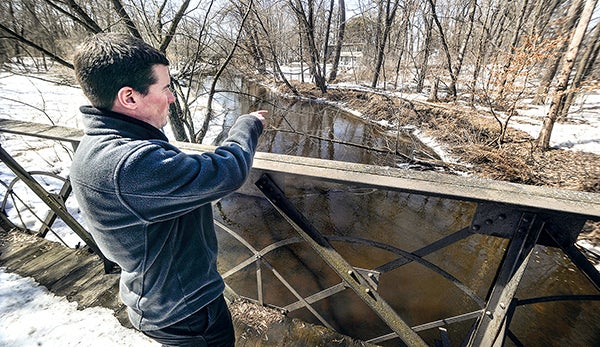Watershed officials get $1.5M for Dobbins Creek
Published 10:28 am Thursday, March 27, 2014

Resource specialist for the Cedar River Watershed District, points out points along Dobbins Creek where steps have been taken to ease shore erosion. The CRWD has been awarded a $1.5 million grant improve Dobbins water quality. – Eric Johnson/Austin Daily Herald
By Trey Mewes, Austin Daily Herald
AUSTIN — Local watershed officials are getting a $1.5 million boost from the state for an ambitious project to better water quality in Dobbins Creek.
The Cedar River Watershed District received a grant Wednesday from the Minnesota Clean Water Fund to move forward on a $2.1 million initiative to implement a series of projects along the Dobbins Creek Watershed’s 25,700 acres over the next few years.
“This is a pretty big event for us,” said Justin Hanson, resource specialist with the watershed district. “We’ve been around since 2007, and this grant marks a big opportunity for us to take a significant project and tackle it.”
The targeted watershed demonstration program, also requires district officials to match the grant with $200,000 in funding, and officials say Vision 2020 is helping to get $100,000 from The Hormel Foundation.
Dobbins Creek, which flows through the J.C. Hormel Nature Center and into East Side Lake, eventually enters the Cedar River at Driesner Park. It has had its share of water quality issues over the years, according to Hanson. Water flows quickly through the area, which stacks sediment and other nutrients in the watershed while pushing a lot of water through the Austin area.
A 2012 Minnesota Pollution Control Agency report called Dobbins Creek impaired in its aquatic life and turbidity, or the amount of water that’s muddy or cloudy.
In the past, CRWD officials have finished projects that either help aquatic life, decrease bacteria or improve water quality, but the new grant will allow officials to plan more projects to tackle several issues such as field erosion, holding water and sediment before it gets to Dobbins Creek, treating nutrients between the fields and creek, stabilizing eroding streambanks and restoring in channel features that support plant and animal life. Officials say tackling all that ultimately improves aquatic life within the watershed.
“This grant is going to give us an opportunity to take a more holistic approach to our water quality efforts,” Hanson said.
Watershed officials will spend 2014 researching the Dobbins Creek Watershed using previous watershed mappings to identify troubled areas along Dobbins Creek. Over the next few years, watershed officials will work with area landowners on projects to improve water quality and increase plant and animal life in the watershed.
“This project doesn’t just tackle one thing, it tackles all these issues,” Hanson said. “And we’re also going to bring along some flood reduction right along with it.”
If the project is successful, it could serve as a model for other watersheds to use dollars targeted for overlapping projects to reach the same goal.
Matt Drewitz, clean water specialist with the Minnesota Board of Water & Soil Resources, said the CRWD’s unique approach was the key to its successful grant bid.
“Altogether, they have a good plan to make changes in a shorter period of time,” he said.



